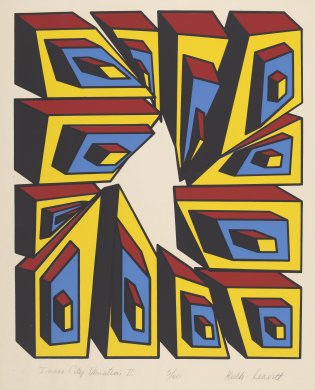By Eduardo Mac Entyre and Miguel Ángel Vidal
The following text is included in the catalogue for the special exhibition Electric Op, on view through January 26, 2025. The abstract painters Eduardo Mac Entyre and Miguel Ángel Vidal inaugurated the Arte Generativo (Generative Art) movement with this manifesto in 1960. They subsequently helped found the Grupo de Arte y Cibernética (Art and Cybernetics Group), an interdisciplinary collective of artists and technologists that formed in Buenos Aires in March 1969 and disbanded in 1973. With the help of engineers at a local technical school, the artists—many of whom were affiliated with Op art, like Mac Entyre and Vidal—were able to use an IBM 1130 2-C to produce computer prints that echoed (and in some cases copied) their paintings. These were included in the first exhibition of computer art in Argentina, Arte y cybernética (Art and Cybernetics), which was presented from August to September 1969 and organized by another Argentine group, the Centro de Arte y Comunicación (CAyC) (Center for Art and Communication). In 1973, the Grupo de Arte y Cibernética was included in the New Tendencies exhibition tendencies 5, in the wake of that group’s own turn from Op to computer art.

Explanation of terms:
GENERATIVE: that which has the capacity to engender.
ENGENDER: to procreate, to propagate the species, to cause, to make to happen, to form.
GENERATOR: It is said of the line or figure that by its movement engenders in its turn a different or new geometric body.
This does not attempt to be a theoretical thesis but a clarification of concepts. We do not deny that we start from the teachings of formal art, especially that school known as Concrete Art. But we do not belong to that school.
For those who believed that the road of formal art had reached a dead end, of art that dared to think, for us the most spiritual and most abstract (since it rested and based itself in mathematical and geometrical developments of great precision resulting in increased abstraction) that the human mind had as yet conceived; for those who believed that they had reached the final development by placing a point or a line in the limited plane that they might live in a universal space; for those who believed that it was impossible to go beyond the orthodox plastic problems; for those who believed that the end of the line had been reached in terms of that “insensitive and cold art” (since that is what they believed about Concrete Art, mistakenly no doubt and owing to their lack of visual education that might have led them to adjust their sensibility to those wonderful and perfect mental artistic solutions) we wish to make this declaration: that we have taken that small point and that line as our starting point but allowed them movement, we have ENGENDERED movement.
The point, meaning a circle (if it comes to that) and the line, in themselves GENERATE their own movement, insofar as we have freed them, made them vibrate, gyrate, thus identifying them not only with the present but also with the future.
We have not only made these figures move within the basic plane with a directional sense from left to right or vice versa, but we have also given them a life of their own to the extent that they give the impression of penetrating and darting forth, thus breaking the basic plane without remaining adhered to the plane surface. They grow and become smaller, they generate themselves progressively, they turn and vibrate; they gyrate within their own form and vibrate by intermingling with each other. They produce contrast and chiaroscuro. They take on a new type of life and attain a new identity in space. This is why we have accepted the term “Generative Art” proposed by Ignacio Pirovano. We coincide with his line of thought. We find in his words the exact description of the motivations for our current work.
Generative painting ENGENDERS a series of optical sequences through the development generated by a form, for example a circle, a square, etc. insofar as these adopt a series of new positions in either the contrary or consecutive sense, following a perfect generative development that completes itself in one unique total form and other interior forms that may also be observed.
There can be no doubt that this painting is also identified with our technological era, in some way preferring to become attuned to it rather than seek to evade it, which is absurd, since technology can also be a source of beauty if rightfully acknowledged. This helps to show that our art is also capable of producing STRENGTH AND ENERGY.
STRENGTH is shown in the fact that the forms produce the sensation of coming away from and penetrating into the basic plane, and ENERGY because in the changing positions and vibrations they transmit energy.
We also believe with PIROVANO that the term Generative should not become a cause of limitation but on the contrary it must help to include all future and legitimate investigations that engender a new beauty wherever happy mortals with creative capacity may be able to find it.
Translated into English in María Cristina Rossi, Eduardo Mac Entyre: Sutilezas de la línea /Subtleties of the Line (Buenos Aires: Yoeditor, 2017), p. 313.
Originally printed in Spanish on the occasion of the artists’ exhibition Arte generativo at the Galería Peuser in Buenos Aires, September 1960. To read more artist perspectives as well as original critical essays, pick up the catalogue for Electric Op in the Buffalo AKG Art Museum Shop.








